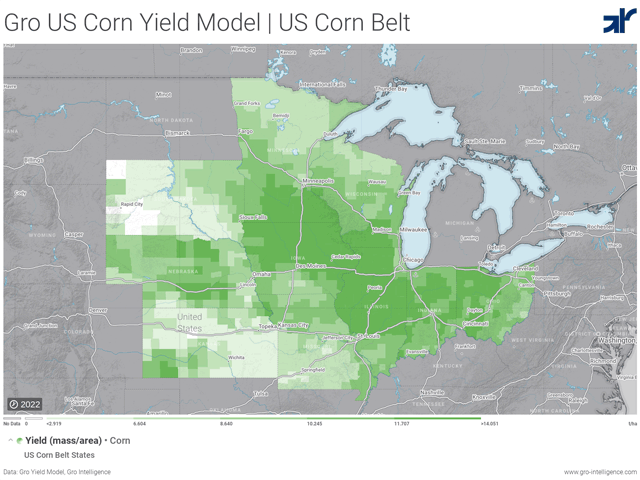2022 DTN Digital Yield Tour: Final Update
Gro Intelligence Models Project Corn Yield at 169.8 BPA, Soybeans at 48.9 BPA
MT. JULIET, Tenn. (DTN) -- Gro Intelligence estimates the 2022 corn crop will average 169.8 bushels per acre (bpa) nationally, while soybeans will average 48.9 bpa.
Both are lower than USDA's November estimates of 172.3 bpa on corn and 50.2 bpa on soybeans.
Gro Intelligence's yield models update daily throughout the growing season as new data becomes available. The models incorporate a wide array of public and private crop and environmental data including NASA's satellite imagery, land surface temperatures, rainfall, USDA crop condition surveys, crop calendars, weather forecasts and much more.
Gro Intelligence Senior Analyst Jon Haines said the model produced its final estimates in mid-October and he thinks USDA will lower its yield estimate in January's Annual Crop Production report. USDA rarely makes an adjustment to corn or soybean production estimates in December.
Gro's yield numbers would peg corn production at 13.720 billion bushels (bb), down 210 million bushels (mb) from USDA's November projections. Soybean production would be pegged at 4.235 bb, down 111 mb from USDA's projection.
P[L1] D[0x0] M[300x250] OOP[F] ADUNIT[] T[]
Haines said the Gro yield models didn't change too much throughout the season. Each spring, the models start with a trendline yield estimate, but based on weather models and early season data, Gro's corn yield model dropped to around 170 bpa pretty quickly. "Then the crop never was really able to recover from the drag of that late planting and early difficulty."
In late July and early August, one of the larger input components of Gro's yield models -- the American weather model, which is also called the Global Forecast System (GFS weather model) -- predicted some very hot temperatures at critical pollination periods. That caused some volatility in the corn yield model, but when the weather didn't materialize as forecast, the model corrected.
Gro Intelligence's corn and soybean yield models powered the DTN Digital Yield Tour in mid-August. You can read more about the yield models and state-by-state crop forecasts here: https://spotlights.dtnpf.com/…
"So, we ended up just below 170 bpa by the end of the season, but we were really there the whole time, and much, much earlier than USDA's methodology would allow them to go," Haines said.
One of the biggest differences between USDA and Gro's yield estimates is the Illinois corn crop. USDA is forecasting a 215-bpa-statewide average, while Gro is at 205.
Gro Intelligence Senior Analyst Will Osnato said USDA's Illinois estimate, if true, would break the 210 bpa record set in 2018. Gro's yield models factor in what's called the Normalized Difference Vegetation Index (NDVI), which gauges the relative greenness of a crop based on NASA satellite imagery.
"At no point was it higher than previous peaks," Osnato said. Gro's yield estimate for Illinois is still the highest of the 10 states covered in the DTN Digital Yield Tour, "But it's not five bushels better than the previous record. Given how big of a state it is, if you take USDA's estimate down a little bit, then the national USDA number comes a little bit closer to us."
USDA will release its Crop Production Annual Summary on Jan. 12, 2023. It will contain the agency's final estimates, although the agency sometimes makes another revision after the September Grain Stocks report reveals more details about actual consumption levels.
Katie Dehlinger can be reached at katie.dehlinger@dtn.com
Or you can find her on Twitter at @KatieD_DTN
(c) Copyright 2022 DTN, LLC. All rights reserved.






